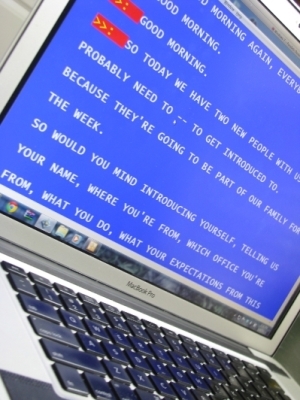
Differences Between CART and Captioning
Have you ever found yourself in the position where you have a client, student, or colleague request accommodations according to the Americans with Disabilities Act, specifically CART (Communication Access Realtime Translation) or closed captioning? There are several methods of providing the spoken word to those who are deaf or hard of hearing, and in this blog article we’ll focus on CART and captioning, their differences, and what you need to know if you are confronted with this request.
Most people are familiar with captioning because they’ve seen it on their own televisions or in a restaurant that may be displaying it on their televisions. Captioning is a method of displaying the spoken word through an encoder onto a screen (usually a television or large projection screen) for either a live or recorded event.
CART is also a method of capturing the spoken word and displaying it for the consumer(s) to view. This can either be displayed on a laptop computer for one individual consumer, or it could be projected onto a large screen for multiple consumers to view at the same time. The latter method is ideal for conferences or large meetings. CART on a laptop could be used in a smaller setting such as high school or college classes, training sessions, medical appointments, or small meetings.
Both methods use the same basic process: a court reporter will attend the event, taking down the spoken word on her stenography machine, which is connected to her laptop. The information is then electronically transmitted to a laptop, overhead projector, or encoder for the consumer(s) to view.
If you receive a request from a consumer for CART or captioning for an event, the first thing you will need to do is find a qualified court reporting firm who employs court reporters with that skill set. Not every court reporter is prepared or skilled to provide CART and captioning. There are certifications court reporters can attain through the National Court Reporters Association (NCRA). They are Certified Realtime Reporter (CRR) and Certified Broadcast Captioner (CBC). So be sure to ask the court reporting firm for a certified court reporter. You will also need to determine if you need CART or captioning services, as each requires specific equipment, and the costs for each could vary.
In order to provide the best services for you and the consumer, it is extremely helpful if you can provide the court reporting firm with as much information or printed material ahead of time. This may include printed speeches, PowerPoint presentations, names of speakers, or any complicated or technical terminology that may be discussed during your event.
Once you find a qualified court reporting firm, they can usually walk you through the specifics of your event and help you determine anything additional you may need.
To help you make sure you have gathered all the details needed when scheduling your next CART or captioning event, download the Quick CART and Captioning Scheduling Checklist.
[cta id=”4200″]
ABOUT THE AUTHOR:
Angie Starbuck, RPR/CRR, is a court reporter in Columbus, Ohio, and the owner of PRI Court Reporting, LLC. Connect with her on LinkedIn and Google+.